#Mellisuga helenae
Explore tagged Tumblr posts
Text
BOTD: Bee Hummingbird

Photo: Arturo Ruiz Villanueva
"What’s perhaps the most amazing thing about the Bee Hummingbird is its tiny size. It measures only 2.24 inches (5.7 cm) in length, including its bill! Truly as light as feathers, this minuscule denizen of Cuban woodlands weighs only about 2 grams. Its appearance and flight style rivals that of some insects, especially bees, for which it gets its name. The Bee Hummingbird is also the bird with the smallest nest in the world, at only 1 inch in diameter and depth. Their eggs are also the smallest bird eggs in the world, measuring a mere 12.5 x 8.5 mm, the size of a coffee bean. A Bee Hummingbird egg is only half the weight of a standard paper clip!"
- Whitehawk Birding
#birds#bee hummingbird#birds of north america#north american birds#birds of the caribbean#hummingbirds#birding#bird watching#birdblr#birblr#bird of the day#Mellisuga helenae
95 notes
·
View notes
Photo

Bee Hummingbird
172 notes
·
View notes
Text
Critter fact #153:

The bee hummingbird (Mellisuga helenae) is the smallest bird in the world. It is found in the Cuban archipelago, and males (shown below) are more colorful than females, which are mainly green and white
2 notes
·
View notes
Text

2 notes
·
View notes
Text
PÁJARO MOSCA
MELLISUGA HELENAE NOMBRE CIENTÍFICO: MELLISUGA HELENAE. LONGITUD: 5 A 6 CM. PESO: HASTA 2 GRAMOS. PLUMAJE: DIFERENTE PARA AMBOS SEXOS. MIGRACIÓN: NO MIGRATORIO. ESTADO: MENOR RIESGO. UBICACIÓN: CUBA, ISLA DE PINES. LA MÁS PEQUEÑA DE TODAS LAS AVES, EL PÁJARO MOSCA O ZUNZUNCITO MACHO PESA SÓLO 1,6 GRAMOS. ES VERDE, CON LA PARTE INFERIOR DE COLOR BLANCO GRISÁCEO Y CABEZA DE COLOR ROJO FURIOSO…

View On WordPress
0 notes
Note
I wanna see the tiniest smallest birds you have!
Well thats an easy one!

Bee Hummingbird (Mellisuga helenae), male, family Trochilidae, order Apodiformes, endemic to Cuba
This species is the smallest bird in the world, weighing in at a maximum of only 2.6 g.
photograph by Falko Düsterhöft

photograph by Dave Curtis

photograph by RitaIvanauskas
949 notes
·
View notes
Text

[https://www.inaturalist.org/observations/97821102]
Bee Hummingbird || Mellisuga helenae
Observed in Cuba
Near Threatened in location of observation
Smallest dinosaur ever known
#hummingbird#birds#nature#wildlife#photography#air beast#who cooks for queue? who cooks for queue all?#100
168 notes
·
View notes
Text
i learned about the top 5 curious facts.
1. The worst traffic jam in history lasted 9 days:

This real nightmare took place in the Chinese capital Beijing, in August 2010. The congestion of more than 100 km, which blocked much of the Beijing-Tibet Expressway, was caused by road works and excessive vehicles.
2. The smallest bird in the world is the size of a little finger:
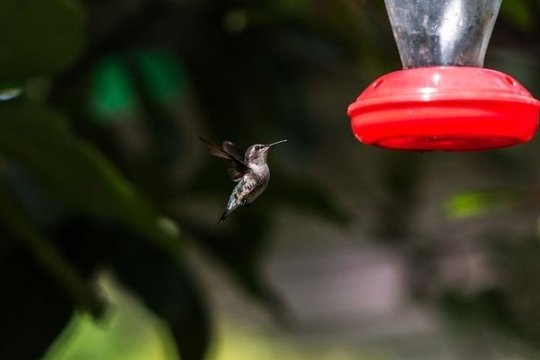
This is the bee hummingbird ( Mellisuga helenae ), a type of hummingbird that lives in Cuba. At just 5.7 cm long and weighing less than 2 g, the little hummingbird bears the Guinness title of the smallest bird in the world.
3. The ostrich has an eye bigger than the brain:
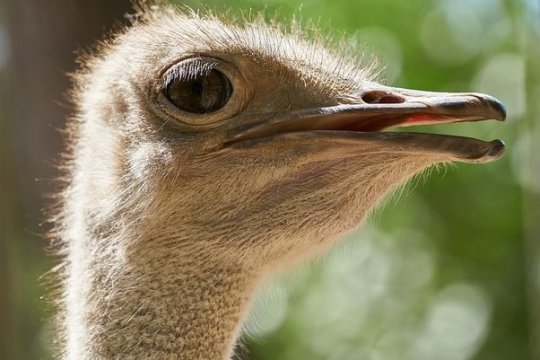
The ostrich, the largest bird in the world, is not only impressive for its size, but also for the size of its eyes, which measure around 5 cm in diameter. It is twice the size of the human eye and comparable to the size of a billiard ball.
4. Whale vomit could be worth millions:
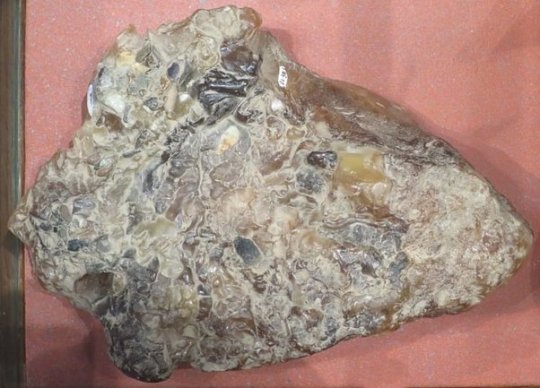
It is ambergris, a substance produced in the digestive system of sperm whales. Also known as “floating gold”, ambergris is used in the manufacture of perfumes and, as it is very rare, it has a very high market value. In 2020, a Thai fisherman found a 100 kg piece of amber on the beach valued at 17 million reais.
5. There are two countries in the world where no one can buy Coca-Cola:
At least officially, there is no Coca-Cola in North Korea and Cuba. The American multinational, manufacturer of one of the most consumed beverages in the world, does not operate in these two countries due to trade embargoes imposed by the United States.
200 notes
·
View notes
Note
What are the biggest and smallest iridescent birds?
Hello dear Anon! As our bird interest is a bit of a new thing, some research was in order to deduct our answer, and we're still not quite sure. However, we've given you our best attempt. For something perhaps more professional, you might want to go to a-dinosaur-a-day, who we believe is actually qualified to talk about this. We're just a guy obsessed with birds.
Now, explanation out of the way -- the smallest we can tell you with certainty. It is the bee hummingbird, a tiny, the smallest, in fact, bird in the world.

The bee hummingbird (Mellisuga helenae) is only 2 inches long. Females are slightly longer, but only by a small fraction, and usually lay two eggs, with them being the size of coffee beans. Let that sink in. While their iridescent feathers are not as notable as their other hummingbird relatives, they are still there, and still as shiny as ever.
Now, here's where it gets tricky. We're not sure what the biggest iridescent bird is. Taking a guess, we'd say it's the peafowl. But when you look this up, you don't get a concrete answer, which makes sense, because no offense, no one ever asks this question. But don't worry! We side with you here -- we're just as curious.
Well, we've been doing some math here. At first, we were thinking of the microraptor, wondering if a prehistoric bird would count before we remembered the peafowl exists. But we put it to the side. Then, we remembered the resplendant quetzal and its ginormous tail -- we looked around different pages and totaled the tallest possible quetzal to be around 4 foot on the higher end, but it still wasn't enough. So we looked up the peafowl.
The peafowl has 3 types -- all sharing traits but all fairly different in ways. The one we're focusing on right now is the green peafowl.
The green peafowl (Pavo muticus) is the largest peafowl of the three. As its name suggests, it is primarily green, while the indian is primarily a bluish color, and congo variants are kind of brown.
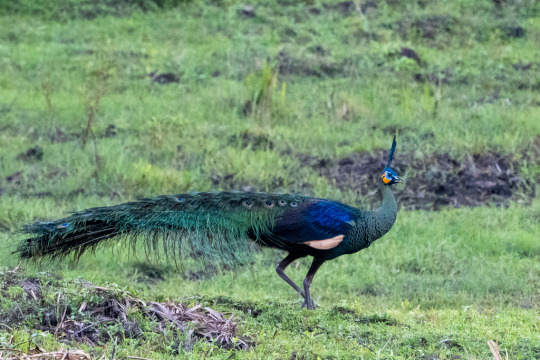
This is the bird we're talking about here. While maybe not in height (but probably in height), it's definitely in length. Males, pictured above, can be 5 feet and 11 inches at lowest to 9 feet 10 inches at highest. And its iridescence is everywhere, from its tail to its beak, basically.
Honestly, we'll be shocked if this isn't the biggest. Wikipedia describes the green peafowl as 'perhaps, the longest extant wild bird in total beak-to-tail length', as well.
We hope this answers your and anyone else's questions, Anon!
TL;DR: It's the bee hummingbird and green peafowl. Probably!
#and take this w a grain of salt#bird#birdblr#avian#iridescent bird#birding#birds#game birds#game bird#pheasant#pheasants#peacock#peafowl#peahen#green peacock#hummingbird#bee hummingbird
27 notes
·
View notes
Text











Mellisuga helenae, better known as the bee hummingbird, zunzuncito, the smallest dinosaur, or Helena hummingbird, is a species of hummingbird endemic to the entire Cuban archipelago, including the main island of Cuba and the Isla de la Juventud in the West Indies. Here bee hummingbirds live in fragmented patches of dense forests populated with woody vines and epiphytes. The diet of the bee hummingbird typically consists of flower nectar, tree sap, insects, & spiders. It is a diurnal bird that can fly at 40–48 km/h (25 to 30mph), beating its wings 80–200 times per second. In a typical day, bee hummingbirds will consume up to half their body weight in food. With males reaching around 2.13 inches (5.5cms) in length and .07 ounces (1.95g) in weight, whilst females reach around 2.38in (6.1cms) in length and .09 ounces (2.6g) in weight, the bee hummingbird is both the smallest species of hummingbird and the smallest species of bird alive today. Compared to other small hummingbirds, which often have a slender appearance, the bee hummingbird looks rounded and plump. The male has a green pileum and bright red throat, bluish upper parts, and greyish white underparts. Female bee hummingbirds are bluish green with a pale gray underside with white spots on the tips of there tail feathers. During the mating season, males have a reddish to pink head, chin, and throat. The bee hummingbird's breeding season is March–June, during such time males court females by producing sound with there tail feathers. If success the two shall mate, with the female then constructing a cup shaped nest out of cobwebs, lichen, and tree bark some 9.8 to 16.4ft (3 to 5m) off the ground. Here she will lay 1 to 2 eggs are incubated for 21 days by only the female, followed by 2 days of hatching, and 18 days of care by the mother. Under ideal conditions a bee hummingbird will reach sexual maturity at around 1 year of age and may live up to 10.
#bee hummingbird#hummingbird#bird#dinosaur#pleistocene pride#pliestocene pride#ornithology#avian#animal facts
11 notes
·
View notes
Text
This is Amarílis, the giraffe who had a neck bigger than the world and who dreamed of backpacking. It was created by the smallest birds in the world (until then), the "Mellisuga helenae" and loves to read Clarice Lispector! 🌳
3 notes
·
View notes
Text

youtube


Mellisuga helenae, también conocido como zunzuncito, colibrí zunzuncito, pájaro mosca, o elfo de las abejas.
es un habitate de Cuba, siendo la especie más pequeña de las aves en general. gracias al naturalista y científico aleman de apellido Gundlach tenemos el descubrimiento del lindo colibrí, el cual fue enseñado al mundo en el libro de "Las aves de Cuba", escrito por Lembeye en 1850. Mellisuga es un referente a su costumbre de succionar miel o néctar y helenae a Helena Booth, quien alguna vez fue esposa del compañero de estudios de Gundlach.
su vuelo es compuesto por la agitación de las alas unas 80 veces por segundo, durando bastante tiempo en el aire en una misma posición para así beber el néctar sin necesidad alguna de tomar reposo en las flores. un negro y fino picó adorna su rostro, el cual contiene internamente una lengua de tono rojo oscuro, sumamente fina y de larga longitud con la cual se alimenta al introducirla en las flores. es dueño del segundo ritmo cardíaco más veloz de todos los animales y al mismo tiempo es el ave con una cantidad muy mínima de plumas. contiene la temperatura corporal más alta de todas las aves al estar a 40 °c durante el día mientras que en la noche está dismuye a los 19 °c, lo que le permite ahorrar energía. consume la mitad de su peso en alimento [ el cual incluye principalmente néctar e insectos ] y hasta ocho veces su peso en agua por el día.
puede ser visto en bosques, bosques bajos y jardines en la isla de Cuba y la isla de la juventud.
0 notes
Text
Factoide #4261
(#4261) Zunzuncito, el pájaro más pequeño del mundo Nombre común del pájaro más pequeño del mundo Es conocido como colibrí zunzuncito, zunzuncito, en inglés Bee Hummingbird. Características y descripción Mellisuga helenae o zunzuncito es considerado como el pájaro más pequeño del mundo, los machos presentan medidas que oscilan en 5.5 cm y peso de 1.9 g, las hembras son un poco más grande, sobre los 6 cm de longitud y 2.5 g de peso medio. El macho posee colores más intensos que las hembras, con marcas rojizas en la cabeza y garganta, que se funden con otros colores iridiscentes más oscuros, la parte ventral es clara. La hembra no posee manchas rojizas y presenta un verde azulado que se extiende por su espalda. Las patas y cola son cortas, el pico también es corto, especialmente si se compara con otros individuos de la misma familia. Disponen de una gran quilla y gracias a las articulaciones presentes en hombros, sus alas están adaptadas para girar 180º. La lengua del zunzuncito, por su parte, es larga y protráctil, adaptada para succionar el néctar de las flores. Alimentación ¿Qué come el zunzuncito? El zunzuncito se alimentan de néctar, también de pequeños insectos especialmente llegada la época de reproducción. Reproducción del zunzuncito
Como dato curioso de la pequeñez de estas aves es de destacar que su nido no es mayor que una cáscara de nuez, los huevos, por su parte, son del tamaño de un guisante. La reproducción del pájaro más pequeño del mundo sucede a finales de la estación húmeda, los machos se concentran en grupos y emiten entonaciones para atraer a las hembras, estas eligen al que consideran más adecuado, aunque un macho puede reproducirse con varias hembras en una misma temporada. El apareamiento se realiza en el aire o en lugares que eligen a modo de posaderos. La hembra es la encargada de la confección del nido, tipo taza, el cual elabora con musgo, cortezas, plantas, liquen, etc. También se encarga de alimentar a las crías. La puesta comprende una media de dos huevos, que eclosionan a partir de los 14 días. Los pollos se empluman y pueden comenzar a volar a partir de los 19 días. Son adultos sexualmente al año de vida. Aporte de Angélica Dávila

[Publicado originalmente el 13 de Julio del 2023]
0 notes
Text
Ave Zunzuncito - Cuba 1977
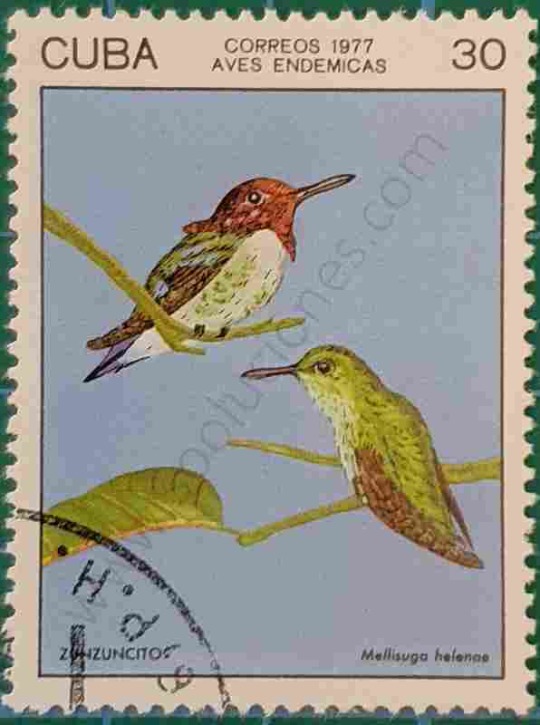
Ave Zunzuncito - Cuba 1977Aves endémicasLa serie de sellos emitida en 1977 por Cuba está dedicada a las aves endémicas.Las aves endémicas son un patrimonio natural que brinda servicios ambientales poco conocidos por la población. Mantienen el balance de los bosques y humedales, aportan a la dispersión de semillas y de esta forma a la regeneración de los bosques y hacen un gran trabajo en el control de plagas. Proteger las especies endémicas no solo es importante para su supervivencia, sino que también tiene una serie de beneficios para los ecosistemas, las comunidades y las economíasEl zunzuncito o pájaro mosca (Mellisuga helenae) es la especie más pequeña de los colibríes y de las aves en general. Habita sólo en Cuba. Fue descubierto por el naturalista y científico alemán Juan Cristóbal Gundlach en 1844Sello “Zunzuncito - Mellisuga helenae” - Aves endémicasSi tienes este sello antiguo de Cuba con Zunzuncito - Mellisuga helenae, y tienes alguna consulta deja un mensaje en este artículo (post), utiliza el enlace “Deja un comentario” al principio del post (al lado de la fecha). Zunzuncito - Mellisuga helenae Catálogo Sooluciones Nº 03946 - Sello de Cuba. 25/02/1977 Sello de Cuba Aves endémicas Información del sello: Catálogos: Michel: CU 2201. Yvert et Tellier: CU 1991, Stanley Gibbons: CU 2357. Stamp Number CU 2125. Formato de la pieza Sello. Valor facial del sello 30¢ - Centavo Cubano. Tamaño del sello ancho y alto: 33 x 45 mm. Dentado: Peine 12 3/4. Marca de agua: No . Tipo de impresión de la estampilla Litografía offset. Colores: Multicolor. Cantidad de sellos postales emitidos 795.000. Serie: Aves endémicas. Temáticas: Animales, Fauna, Aves, Colibríes, Sellos Cuba 1977. Formato: Sello. Categoría: Conmemorativo. Precios de Venta o Compra de sellos aproximado vistos en internet: Precio mínimo estimado: 0,75 € (euros) Precio máximo estimado: 3 € (euros) Datos actualizados junio, 2023 Ave Zunzuncito - Cuba 1977 Comienza tu aventura filatélica hoy mismo: Agrega sellos postales a tu colección. Descubre cómo mejorar tu colección de sellos postales y aprende por qué la filatelia se considera un arte. Encuentra el sello que buscas (país, año, idioma). Con cada sello que agregues a tu colección, tendrás una pequeña obra de arte en miniatura. ¡Empieza tu aventura filatélica hoy mismo! Comienza tu colección de sellos postales con el primer sello y descubre un mundo lleno de cultura y entretenimiento. Si buscas un álbum o catálogo de un sello en particular (país, año, idioma), escríbeme y te avisaré cuando esté disponible. A través del enlace "Deja un comentario" ubicado al principio del post, puedes agregar información para este artículo y mejorar nuestro catálogo. También tenemos fichas para sellos en archivos en formato PDF descargables para imprimir (te ahorras el costo del envío, y el tiempo de espera), en papel normal o papel de 200gr de excelente calidad Para mejorar este catálogo, (número de catálogo, colores, dentado etc), puedes agregar información o informar de un error, para este artículo utilizando el enlace "Deja un comentario" ubicado al principio del post, junto a la fecha. La filatelia se considera un arte y cada sello es una pequeña obra de arte en miniatura. Con cada sello que agregues a tu colección, tendrás la oportunidad de aprender algo nuevo cada día y descubrir diferentes culturas. Si algo no está en un sello, no existe. ¡Empieza tu aventura filatélica hoy mismo! Read the full article
0 notes
Note
Two prompts:
A tiny bird (parrot or otherwise)
A tiny nudibranch
I'm open to either if you don't want to do both. 👍🏻
Well, let's go for the TINIEST BIRD!!!
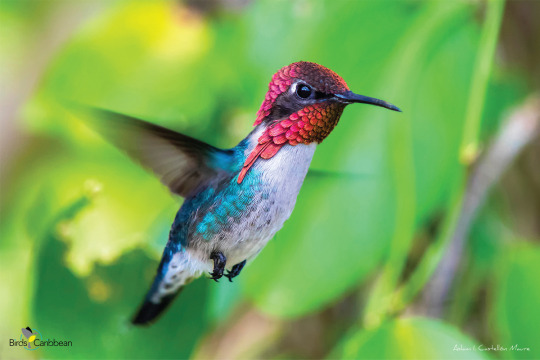
Bee Hummingbird (Mellisuga helenae), male, family Trochilidae, order Apodiformes, endemic to Cuba
This species is the smallest bird in the world, weighing in at a maximum of only 2.6 g.
photograph by Aslam Ibrahim
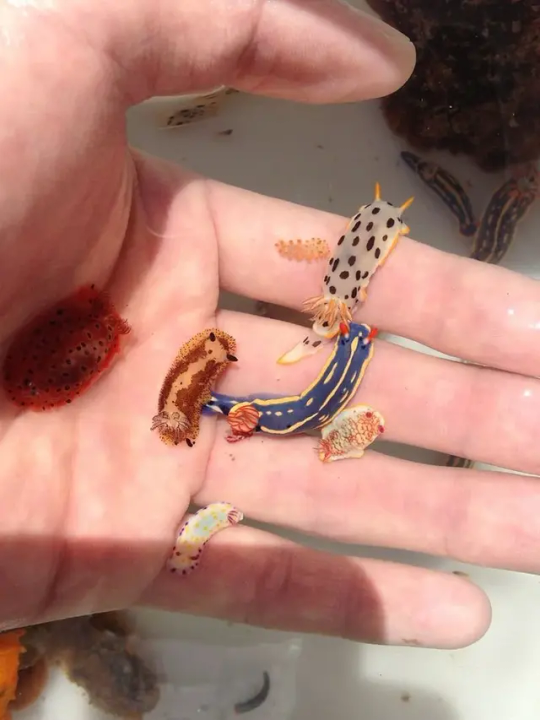
Various nudibranchs (order Nudibranchia)
photograph by Keita Kosoba
513 notes
·
View notes
